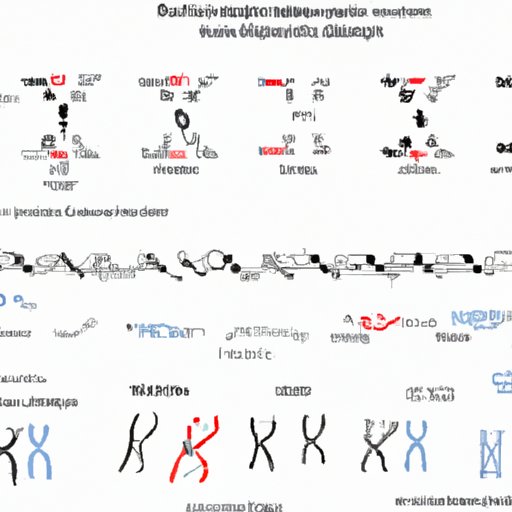Introduction
Messenger RNA (mRNA) is a type of molecule found in all living organisms that carries genetic information from DNA to the ribosome, where proteins are produced. mRNA plays an essential role in the process of protein synthesis, enabling cells to translate genetic information into proteins. In this article, we will explore how mRNA works, from its structure and function to its role in protein synthesis.
Exploring the Basics of mRNA: What is mRNA and How Does it Work?
mRNA is a type of ribonucleic acid (RNA) molecule that is created during transcription, a process in which genetic information stored in DNA is transferred to mRNA. Once mRNA has been transcribed, it is then used to create proteins through translation, a process in which the genetic information contained in mRNA is translated into amino acid sequences that form proteins.
Structure and Function of mRNA
mRNA molecules consist of three parts: the 5′ cap, the coding region, and the 3′ poly-A tail. The 5′ cap is a modified guanine nucleotide that helps protect the mRNA molecule from degradation while also assisting with translation. The coding region contains the genetic code that will be used to create a protein. Finally, the 3′ poly-A tail is a sequence of adenine nucleotides that helps stabilize the mRNA molecule and aids in its translation.
Role of mRNA in Protein Synthesis
mRNA plays an essential role in protein synthesis by providing the instructions for assembling amino acids into proteins. During the process of transcription, genetic information stored in DNA is copied onto mRNA molecules. This information is then used to create proteins through translation, a process in which the genetic information contained in mRNA is decoded and used to assemble amino acids into proteins.
The Role of mRNA in Protein Synthesis: A Step-by-Step Guide
Overview of mRNA Processing
Before the genetic information contained in mRNA can be used to assemble proteins, it must first undergo several processing steps. During these steps, the mRNA molecule is spliced, edited, and transported to the cytoplasm, where it is ready to be translated.
Impact of mRNA Processing on Gene Expression
The processing of mRNA molecules has a profound effect on gene expression. By altering the structure and composition of mRNA molecules, cells are able to control which proteins are expressed and when they are expressed. This allows cells to regulate their physiology and respond to changing environmental conditions.
Decoding the Structure and Function of mRNA
Composition of mRNA Molecules
mRNA molecules are composed of four types of nucleotides: adenine, guanine, cytosine, and uracil. These nucleotides are arranged in triplets, known as codons, which serve as the genetic code that is used to create proteins. Each codon codes for a specific amino acid, and the order in which the codons are arranged determines the sequence of amino acids that will be used to create a protein.
mRNA Transcription and Translation
Transcription is the process in which genetic information stored in DNA is copied onto mRNA molecules. During this process, the enzyme RNA polymerase reads the DNA sequence and copies it onto an mRNA molecule. This process is followed by translation, a process in which the genetic information contained in mRNA is decoded and used to assemble amino acids into proteins.

Understanding the Role of mRNA in Translating Genetic Information into Proteins
Overview of mRNA Translation
Translation is the process in which the genetic information contained in mRNA is decoded and used to assemble amino acids into proteins. During this process, the mRNA molecule is read in groups of three nucleotides, known as codons. Each codon codes for a specific amino acid, and the order in which the codons are arranged determines the sequence of amino acids that will be used to create a protein.
mRNA Codon System
The codon system is the set of rules that govern how mRNA codons are interpreted. There are 64 possible codon combinations, each of which codes for a specific amino acid or serves as a stop signal. The codon system is highly conserved across species, meaning that the same codons are used to code for the same amino acids in different organisms.
Post-Translational Modifications
Post-translational modifications are processes that occur after the protein has been translated. These modifications can alter the structure and function of the protein, allowing it to perform new or additional functions. Examples of post-translational modifications include phosphorylation, glycosylation, and acetylation.
Conclusion
mRNA is a type of molecule found in all living organisms that carries genetic information from DNA to the ribosome, where proteins are produced. mRNA plays an essential role in the process of protein synthesis, enabling cells to translate genetic information into proteins. Through its structure and function, mRNA is able to decode genetic information and assemble amino acids into proteins. Understanding how mRNA works is essential for understanding gene expression and protein synthesis.
(Note: Is this article not meeting your expectations? Do you have knowledge or insights to share? Unlock new opportunities and expand your reach by joining our authors team. Click Registration to join us and share your expertise with our readers.)
